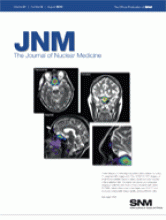TO THE EDITOR: Gutte et al. (1) reported on a novel, exciting concept to diagnose pulmonary embolism (PE) using a γ-camera integrated with a multidetector CT scanner. Interestingly, ventilation–perfusion (V/Q) SPECT alone had almost a 20% false-positive rate caused by interlobar fissures, pleural fluid, and pulmonary pathology, whereas CT of the pulmonary arteries (CTPA) had a 100% positive predictive value. This finding emphasizes that, like a conventional V/Q scan, a V/Q SPECT scan showing mismatched defects requires a recent chest radiograph or preferably a low-dose pulmonary CT (LDCT) scan, conveniently performed with the author's hybrid scanner. However, the value of the reported superior sensitivity of SPECT/LDCT relative to CTPA, and the drawbacks of CTPA due to renal impairment and radiation dose, may be debatable.
One hundred ninety-six patients were recruited during 20 mo, a remarkably low figure for the 2 hospitals mentioned. At the same time, 24% of the patients were excluded because of renal impairment. To me, this indicates that some kind of additional selection criteria were applied in choosing from among the general cohort of patients with suspected PE. For comparison, only 0.7% of patients were excluded because of a glomerular filtration rate of less than 30 mL/min in the large, multicenter Christopher study (2). It should also be noted that CTPA in azotemic patients may be performed with substantially lower contrast medium doses (3,4) than in the present study, therefore disqualifying only a minority of patients for CTPA.
Seven percent of the patients were excluded from CTPA because they were women less than 40 y old. The relatively high effective radiation dose (11 mSv) with the present CTPA protocol may have been the motive. The 2007 Fleischner Society Statement (5), representing a certain expertise in PE diagnosis, indicates that exposure parameters resulting in an effective dose as low as 3–5 mSv is sufficient for an adequate study. In fact, 80- to 100-kVp CTPA with effective doses in the same range as (3.3 mSv) (6) or actually lower than (1.3–2.3 mSv) (6–8) that of the present SPECT/LDCT (3 mSv) have been achieved with preserved or even improved diagnostic quality.
A composite reference standard including the index tests, that is, V/Q SPECT and CTPA, was used by Gutte et al. (1). This choice may introduce incorporation bias (item 7 in the Quality Assessment of Diagnostic Accuracy Studies [QUADAS]) overestimating the various measures of diagnostic accuracy (9). Specifically, mismatched defects of any size and number at V/Q SPECT may then have been taken as evidence of PE, partly explaining the relatively low sensitivity of CTPA while false-positive diagnoses at SPECT/LDCT may still have been present. To the best of my knowledge, there is to date not a single prospective study published adhering to the Standards for the Reporting of Diagnostic Accuracy Studies (STARD) (10), where defined SPECT criteria for a positive diagnosis of PE has been validated with a proper reference standard. Thus, the probability of PE, depending on the size and number or segmental equivalents of mismatched defects on SPECT combined with various clinical likelihoods of PE, is not known.
One may also speculate on whether the high sensitivity of SPECT may diagnose PE that does not need anticoagulation. Several well-conducted outcome CTPA studies (2,11–13) clearly demonstrate that patients with clinically likely PE or a positive D-dimer, with few exceptions, can safely be left without anticoagulation after a negative CTPA result, even if not combined with ultrasonography of the lower legs (14). Thus, the lower sensitivity of CTPA may actually be advantageous relative to SPECT, which may carry the risk of serious bleeding complications from treatment of clinically harmless PE. The potential problem with false-positive and harmless true-positive PE at SPECT/LDCT may not be solved unless we study the outcome of patients with mismatched SPECT/LDCT defects left without anticoagulation after a negative CTPA result.
In conclusion, although having interesting potential in diagnosing PE, hybrid SPECT/LDCT is still a research tool and has to undergo properly performed studies based on the STARD and QUADAS criteria before it can be recommended as the “first-line imaging test in the work-up of PE in most cases.” The drawbacks of CTPA relative to SPECT/LDCT, with regard to contrast media and radiation, are today of minimal concern in nonpregnant patients (15) if contrast media and radiation exposure parameters are optimized.
- © 2010 by Society of Nuclear Medicine







